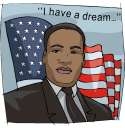
Worksheets and No Prep Teaching Resources
Reading Comprehension Worksheets
Black History and Blacks in U.S. History
The 1960's

Black History and Blacks in U.S. History
 Worksheets and No Prep Teaching Resources Reading Comprehension Worksheets Black History and Blacks in U.S. History The 1960's |
 Black History and Blacks in U.S. History |
| edHelper's suggested reading level: | grades 6 to 8 | |
| Flesch-Kincaid grade level: | 6.77 |
|
The March on Washington
By Jane Runyon |

|
 1 The groundwork for the 1963 march on Washington, D.C., was laid much earlier. As a matter of fact, the first plans for such a march were made in 1941. A man named A. Philip Randolph was the president of a union for railroad porters. At one time, railroads were the major transportation systems in the United States. Porters were the people who handled luggage, checked tickets, and took care of the needs of passengers on these trains. Mr. Randolph worried about job security for these porters during and after World War II. He decided to put some pressure on President Franklin D. Roosevelt by calling for a march of workers on the capital of the nation. President Roosevelt signed an order protecting the jobs of black workers before the march could take place.
1 The groundwork for the 1963 march on Washington, D.C., was laid much earlier. As a matter of fact, the first plans for such a march were made in 1941. A man named A. Philip Randolph was the president of a union for railroad porters. At one time, railroads were the major transportation systems in the United States. Porters were the people who handled luggage, checked tickets, and took care of the needs of passengers on these trains. Mr. Randolph worried about job security for these porters during and after World War II. He decided to put some pressure on President Franklin D. Roosevelt by calling for a march of workers on the capital of the nation. President Roosevelt signed an order protecting the jobs of black workers before the march could take place. |
Create Weekly Reading Books
Prepare for an entire week at once! |
| Leave your feedback on The March on Washington (use this link if you found an error in the story) |
 |
Black History and Blacks in U.S. History
|
 |
The 1960's
|
 |
Dr. Martin Luther King, Jr. Theme Unit and Printables
|
 |
United States
|
|
|
 | Fifty States Theme Unit |
 |
Document Based Activities |